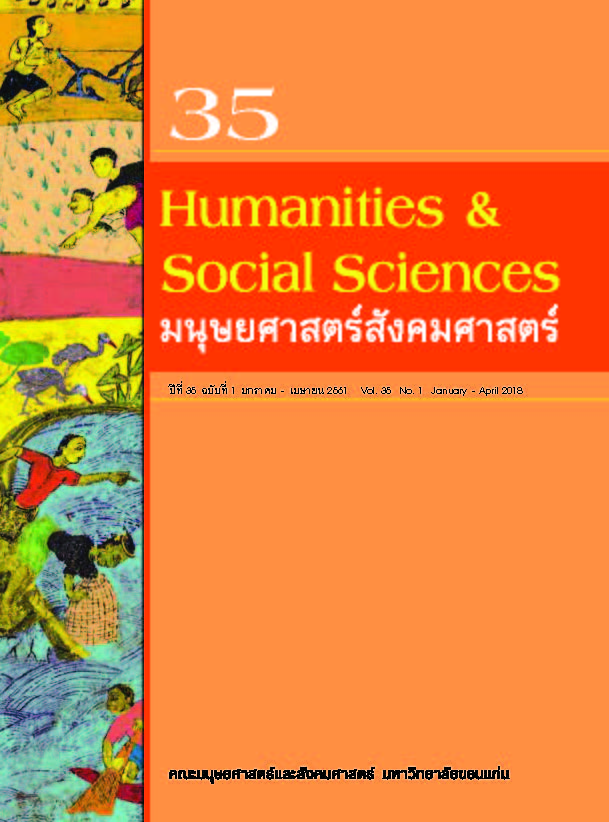ข้อผิดพลาดการใช้คำกริยาวิเศษณ์พ้องความหมายในภาษาจีนของผู้เรียนชาวไทย
Abstract
บทคัดย่อ
งานวิจัยนี้มีวัตถุประสงค์เพื่อศึกษาการใช้คำกริยาวิเศษณ์พ้องความหมาย และลักษณะข้อผิดพลาดในการใช้คำกริยาวิเศษณ์พ้องความหมายในภาษาจีนของผู้เรียนชาวไทย ประชากรที่ใช้ในการวิจัย คือ นักศึกษาชั้นปีที่ 3 สาขาวิชาภาษาจีน คณะมนุษยศาสตร์และสังคมศาสตร์ มหาวิทยาลัยขอนแก่น ในปีการศึกษา 2557 จำนวน 40 คน เครื่องมือที่ใช้ในการวิจัย คือ แบบทดสอบ สถิติที่ใช้ในการวิเคราะห์ข้อมูล ได้แก่ ค่าร้อยละ (Percentage) ผลการวิจัยพบว่า การเลือกใช้คำกริยาวิเศษณ์พ้องความหมาย ที่พบข้อผิดพลาดมากที่สุด คือ กลุ่ม 只、仅、仅仅 ลักษณะข้อผิดพลาดการใช้คำกริยาวิเศษณ์พ้องความหมายพบในระดับคำมากกว่าระดับประโยค คำที่พบข้อผิดพลาดมากที่สุด คือ 不时 ข้อผิดพลาดการใช้คำกริยาวิเศษณ์พ้องความหมายแบ่งออกเป็น 4 ลักษณะ ดังนี้ 1) การตกหล่นของคำหรือส่วนประกอบ (遗漏) แบ่งออกเป็น การตกหล่นของคำกริยา คำช่วยหลังคำกริยา คำประกอบร่วมท้ายประโยค (了、的) และคำกริยานุเคราะห์ 2) การเกินมาของคำหรือส่วนประกอบ (误加) เป็นการเกินมาของคำกริยาวิเศษณ์ และใช้ไม่ถูกกับลักษณะประโยค 3) การแทนที่ผิดความหมาย (误代) ควรใช้คำอื่นแทนคำกริยาวิเศษณ์นั้น ๆ เข้าใจความหมายผิด ใช้คำผิดชนิด ใช้คำประกอบร่วม (不、没) ผิด และใช้ไม่ถูกกับลักษณะประโยค 4) การเรียงลำดับคำหรือส่วนประกอบไม่ถูกต้อง (错序) นอกจากนี้ พบว่าประเภทคำกริยาวิเศษณ์ที่เกิดข้อผิดพลาดมาก ได้แก่ คำกริยาวิเศษณ์ประเภทบอกอารมณ์ บอกเวลา บอกขอบเขต และบอกความถี่
คำสำคัญ: คำกริยาวิเศษณ์พ้องความหมาย ภาษาจีน ข้อผิดพลาด ผู้เรียนชาวไทย
Abstract
The main purposes of this study are to examine Chinese Thai learners’ use of synonymous adverbs and to categorize types of synonymous adverbs errors produced by Chinese Thai learners. The participants of this study were 40 third year Thai learners majoring in Chinese, Faculty of Humanities and Social Sciences, Khon Kaen University, Academic Year 2014. The data were collected using a test and were analyzed for percentage. The results reveal that when selecting synonymous adverbs to complete sentences, the participants mainly made errors in 只、仅、仅仅. Regarding types of errors, the errors were commonly found at a word level, followed by a sentence level. The errors were mostly found in不时. Four main types of errors produced by the learners included 1) missing of words or word parts (遗漏) (i.e., verbs, auxiliary words after verbs, auxiliary words at the end of the sentence 了、的 and auxiliary verbs), 2) unnecessary words or word parts (误加) (e.g., adverbs and misuse of adverbs in sentence), 3) wrong meaning substitution (误代) by using wrong and inappropriate adverbs, word meanings, types of word, misuse with 不、没and misuse of adverbs in sentence, and 4) word order or incorrect elements (错序). In addition, it was found that errors frequently occurred with modal adverbs, adverbs of time, scope adverbs, and adverbs of frequency.
Key words: synonymous adverbs, Chinese, errors, Thai learners



